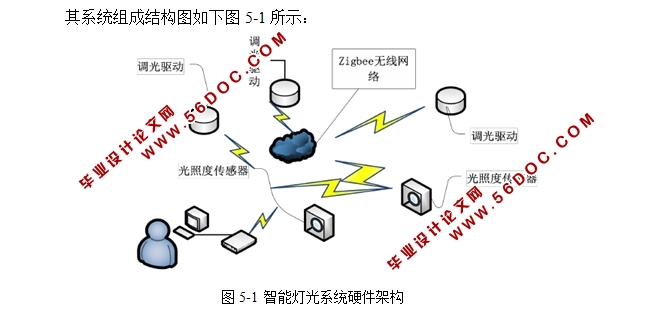基于ZigBee的照明系统设计
来源:56doc.com 资料编号:5D19059 资料等级:★★★★★ %E8%B5%84%E6%96%99%E7%BC%96%E5%8F%B7%EF%BC%9A5D19059
资料以网页介绍的为准,下载后不会有水印.资料仅供学习参考之用. 密 保 惠 帮助
资料介绍
基于ZigBee的照明系统设计(课题说明书,开题报告,中期检查表,论文14000字)
摘 要 在这次设计中主要完成以下四点内容:1、智能灯系统需要基于LED的发光性能特性,初步设计出具有高效率、高可靠性的二次侧反激式拓扑AC\DC恒压驱动电源;2、根据系统确定需要LED调光技术并且设计调光电路;3、掌握ZigBee协议栈架构,选定cc2530MCU、BH1750传感器芯片,完成系统硬件搭建。4、设计了专家PID调光算法,在Z-Stack协议栈平台,完成智能灯光系统的代码开发。
关键词 ZigBee; LED; 无线; 智能照明; 低功耗
Design and Implementation of Wireless LED Lighting System Design (ZigBee)
Abstract In this design, the following five points are mainly completed: 1. The intelligent lamp system needs to be based on the illuminating performance characteristics of the LED, and the secondary side flyback topology AC\DC constant voltage driving power source with high efficiency and high reliability is preliminarily designed. 2. according to the system to determine the need for LED dimming technology and design dimming circuit; 3. master the ZigBee protocol stack architecture, select cc2530MCU, BH1750 sensor chip, complete the system hardware construction. 4. Designed the expert PID dimming algorithm, completed the code development of the intelligent lighting system on the Z-Stack protocol stack platform; 5. Conducted the reliability test to verify the feasibility of the system design.
Keywords ZigBee; LED; Wireless; Intelligent lighting; Low power consumption
智能灯光系统构成概述
本次设计智能灯系统主要包含高效LED灯驱动电源、可调光驱动、光度传感器模块与协调器模块4个组成部分,其中关于 LED 驱动电源与调光驱动,合称为可调光 LED 驱动器。其中驱动电源起到供电总线的作用,调光驱动起到接收网络信号,调节 LED 灯具光照度的作用[19]。

目 录
摘要及关键词 1
1绪论 1
1.1研究背景及意义 1
1.2智能照明系统的研究现状 1
2高效LED驱动电源设计 1
2.1 LED驱动电源的设计要求 2
2.2 DC/AC驱动电源的系统组成 2
2.3 LED驱动电源方案 4
2.4 LED驱动电源方案系统选择 6
3调光驱动的设计 7
3.1调光驱动方案的设计 7
3.2调光驱动的技术方案 7
3.3调光驱动方案的选择 9
4 ZigBee技术研究 10
4.1 ZigBee的技术特点 10
4.2 ZigBee3.0相关技术指标 11
4.3 ZigBee3.0协议栈架构 12
5智能灯光系统的硬件构建 15
5.1智能灯光系统构成概述 15
5.2可调光LED驱动器设计 16
5.3照度传感器电路 17
5.4协调器模块设计 18
6智能灯光系统的软件平台搭建 19
6.1照度传感器模块的调光算法 19
6.2各个硬件模块应用层功能设计 21
6.3软件平台的缺点分析 23
7结论 23
参考文献 23
致谢 26
|



